[2021 The Newest Ultimate Guide ] Branding + Marketing Strategy For The Japanese Market
1. What is Branding ?
Branding is about showing who 'YOU" are as a company or individual person. Successful branding often addresses 4 characters.
Branding shows "Purpose"
Who are you and what is your purpose for the business? There is no right or wrong answer to this question. We are all emotional animals. Typically purpose resonates with its customers more when you can create likability and social good in the purpose like IKEA does.

The purpose should be more than what you want to "Show Off" to the potential customers for the sake of being liked by them to get to their wallets because your fake purpose would not help your organization but rather expose you for who you really are in a long run. So the purpose should be something you can truly resonate with as a company and especially by the management.
Branding shows "Consistency" but, with practicality
Consistency is important because it contributes to brand recognition, which fuels customer loyalty. But in reality, business is not and should not be one-dimensional. So it is much more practical to produce micro materials with a consistency as such that your blog posts should have the same tone in the writing, your color theme and fonts should match across all your branding materials etc, while not letting this pressure of "always delivering with consistency" in the macro vision of the brand.
What people get wrong is that they think brands need to "create" consistency. Consistency is not something you create, consistency is something that happens out of necessity when your macro business purpose ( that we spoke about) is practiced in your business operation.
Branding shows "Emotion"
Why do people pay money?
1) They want to fix their inconvenience.
2) They want to make themselves happy.
What is the common reason behind the two? That's right. This is both EMOTIONAL decision making process.
Most of human actions are predicated on their emotions that being said, if you are able to feed the emotion that customers want with your brand that your competitors or other substitutional brands can not provide for them, you are likely thought of by the customers when they are making a buying decision which becomes customer loyalty.
Branding shows "Flexibility and Relevance"
In this fast-changing world, marketers must remain flexible to stay relevant.
What does this mean? Well GaryVee is right in this video right here when he told us what he thinks of the recent occurrence of Tesla dropping a tequila.
I’ve talked about this before and it’s worth repeating. Some brands have truly established themselves in their sectors which gives them permission to expand in similar albeit different sections of that same sector. I think BMW has done that. Therefore, they “have permission” to make headphones that we would all buy. The BMW logo is cool and matters; plus, we think of them as an engineering company that makes good things. Still, 99 percent of people might say, “No. BMW makes cars.”
I say, BMW can make headphones because they’re one of the brands that have established themselves. They have undoubtedly established something enough to have permission to do something within that target demo that’s executed in a different product or service. They’re not the only ones either. Nine years ago, Apple could have come out with a sneaker and won a large share of attention from people who love sneakers. They were so cool that they could enter that market, then they could innovate, which is their DNA.
I think Porsche and Mercedes should go into other sectors as well. - said Gary
This is the place where you need to be able to fall in love with the market more than your product. You need to be able to play for the market not for your business. When you can play for the market, you realize that surplus demand is more important than your pride to stay consistent within your brand offering in this equation.
Now we understand what "branding" is. Let's talk about what you should do to plan branding strategy when you are entering the new Japanese market
2. What to do in "New Market Entry Branding"
1) Once again, it is very important to understand who you are and what you are trying to achieve as your purpose first and most. Audit yourself and come up with your base belief.
2) When you know what it is, now it is time to decide what your "personality" of the brand should be. Describe what the person would be like if your brand was a person. How does this person communicate? What does this person make others feel? Then finally based on the adjectives you come up with, now you can identify some visual guideline for your brand.
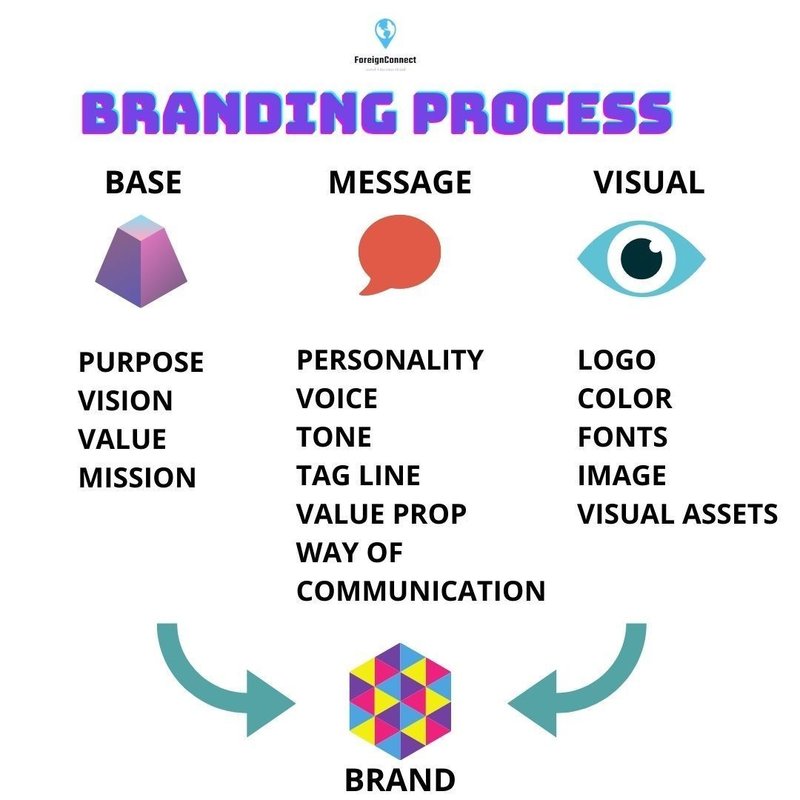
The process of branding in a new country is basically the same process of any regular branding. The most important thing is to know that it is ok to change. Again, the market is always the final judger. If something does not feel right in the new market, you need to know that the market is more important than your pride to be "YOUR BRAND" especially if you are starting a brand in a new country, it's normal to encounter surprises because what perceived as cool in America might not be perceived cool in Japan. These perceptions are highly cultural.
Branding is interesting because branding is the only place in business where "I - the business" get to appear more than "YOU - the customers." The ultimate success equation however again to realize that "I" can only exist because there is "YOU" which means you need to be able to provide for "YOU" at all time.
How can you incorporate this to the branding? First you need to realize what you are good at in relation to the problem of others and how "what you are offering is helpful" for the people you are serving. Always remember, the market is the final judger so what you "think" is helpful or cool might not be helpful or cool in this new Japanese market. When you are entering the new market with a very different cultural stand such as Japan from America, you need to stay flexible and never get too comfortable in settling with one original identity that you brought from America.
You need to understand the context in order for you to deliver a value in a new market.
So what is this mean? This means that there is no such thing as one size fit all solution for anything so if you are starting a new brand in Japan, which means you need to be ready to contextualize that you are speaking to a different audience with potentially a different need and be able to adjust your operations. If you set your purpose based on human needs, rather nation needs, normally, moving to an another country shouldn't require you to adjust as far as your mission or purpose, but it is highly possible that you have to make some adjustment in the way you "deliver" the messages.
For example, the biggest messaging apps used in America is Facebook messenger and what's up but in Japan, the biggest app by far is Line. The biggest shopping site used in America is Amazon, in Japan it is Rakuten. American people communicate much more aggressively than Japanese people. Americans are much more individualistic than Japanese. So people's attention, behavior, presences are different depending on the countries. You need to be able to learn the difference and adjust your business efforts to what makes sense to the specific market. This is why, dividing roles within "Branding" division is a smart thing to do. This way, you can create infrastructure in understanding and incorporating localization in branding.

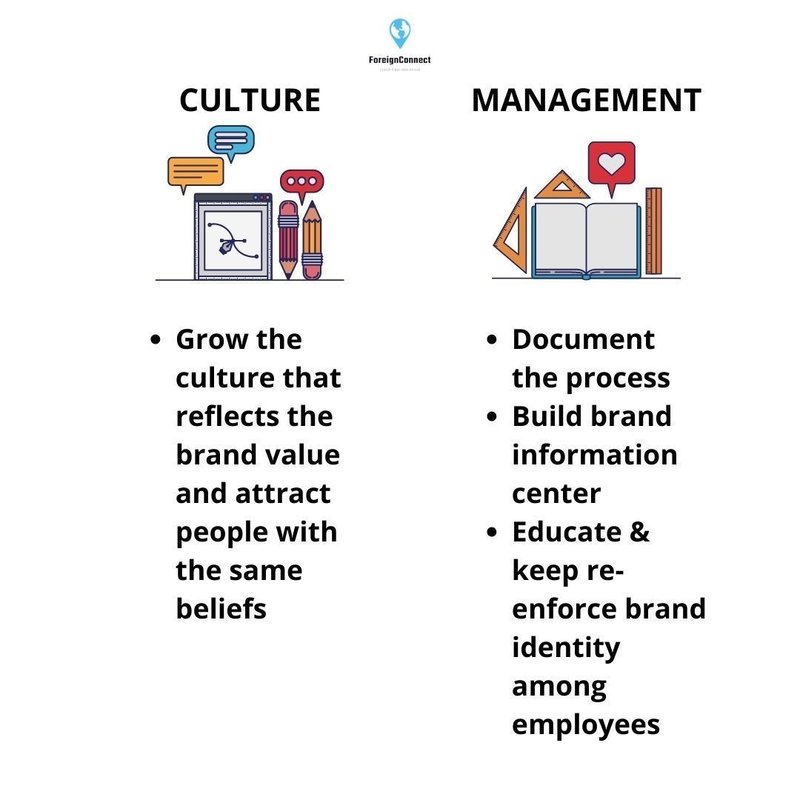
3. Methods
So, how can we achieve all things we mentioned above? Here are hows.
1) Understand Japanese customers' needs around the solution you are providing
So how can you understand the Japanese customers' needs? The worst thing you can do is assuming that you know.. so GO TALK TO THEM! Find opportunities to interact with your potential or existing customers in Japan. You can read this article talking about new market entry, market research where I spoke about finding out the customer needs here. Here are some additional insights about marketing in Japan:
Safety and security are always the first
You would hear pretty much all Japanese company claim their products or service are safe and secure (“安心・安全”). The reason is that that’s what Japanese customers care about.
Quality and details matters
Japanese customers sometimes complain about even a slight wound on a product.
Fresh and trendy catch the attention
Japanese customers like new things. If you walk around Tokyo, there are pop-up shops everywhere.
Japanese care brands
Japanese are very brand-oriented. Louis Vuitton and Gucci are good examples. Looking at Moet Hennessy-Louis Vuitton Group (LVMH) ‘s fashion sales by country, Japan accounted for 26% in 2006 and 22% in 2006.
Review and word of mouth spread
The majority of Japanese consumers base their social and third-party evaluations on purchasing decisions, such as reputation of the company and word of mouth. - So this leads to my nest topic
2) Understand where the attention is
As mentioned earlier, reviews and word of mouth is very important for Japanese people. Also, different apps have different market share in different countries. So you need to understand how to manage your reputation and how to spread the reputation to the audience. Now the question becomes where do people in Japan spend time?
According to the government statistics, people spread their time between doing necessarily things including doing the house work, taking care of children, working on jobs and time spent on the internet.
the longest ( time used in the internet ) was in doing main job and the time used in hobbies - from stat.go.jp
In the recent study, Insider intelligence said that the time spent on watching TV was most increased in the recent coronavirus phenomenon.

Interesting thing to note here is that, even though TV usage is still major consumption in Japan, this graph clearly shows that the attention in the traditional media including TV is decreasing and digital media ( such as on-demand video streaming services and social media) consumption is increasing in Japan.
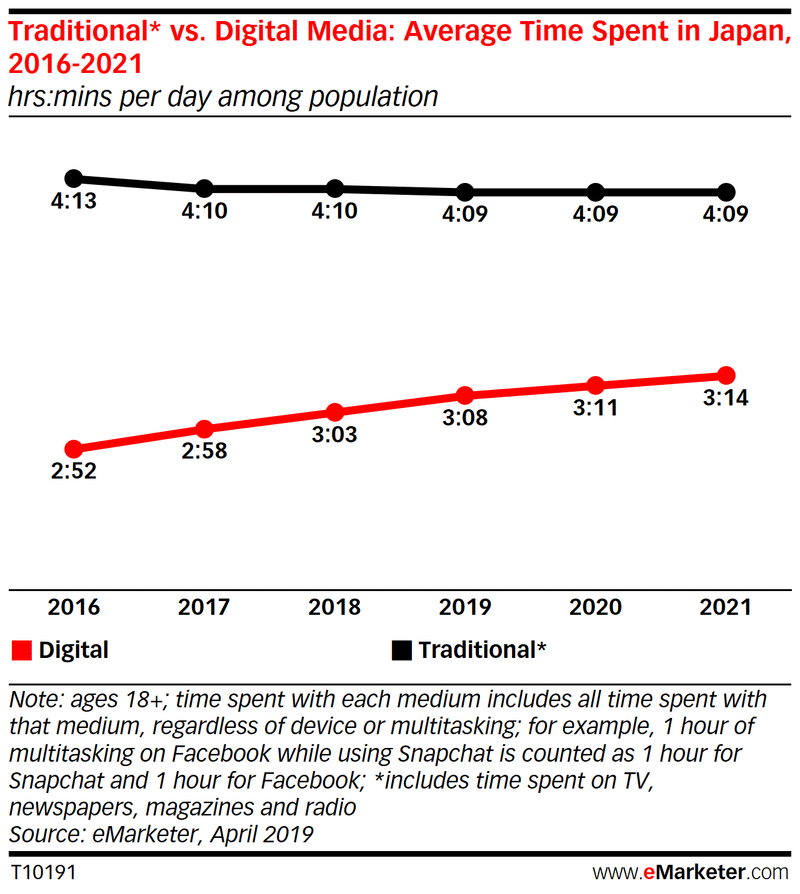
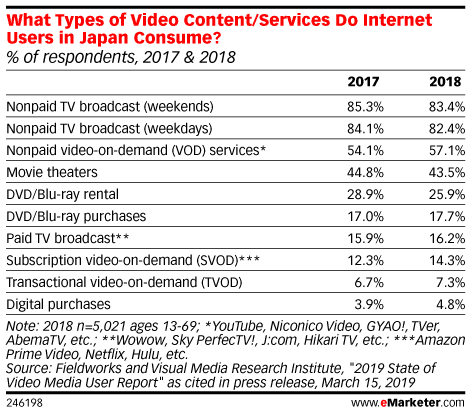
List of most used on-demand video streaming services in Japan are Youtube, Niconico Video, Gyao!, AmebaTV, WOwOw, SkyPerfectTV, HikariTV, Amazon prime Video, Netflix, Hulu
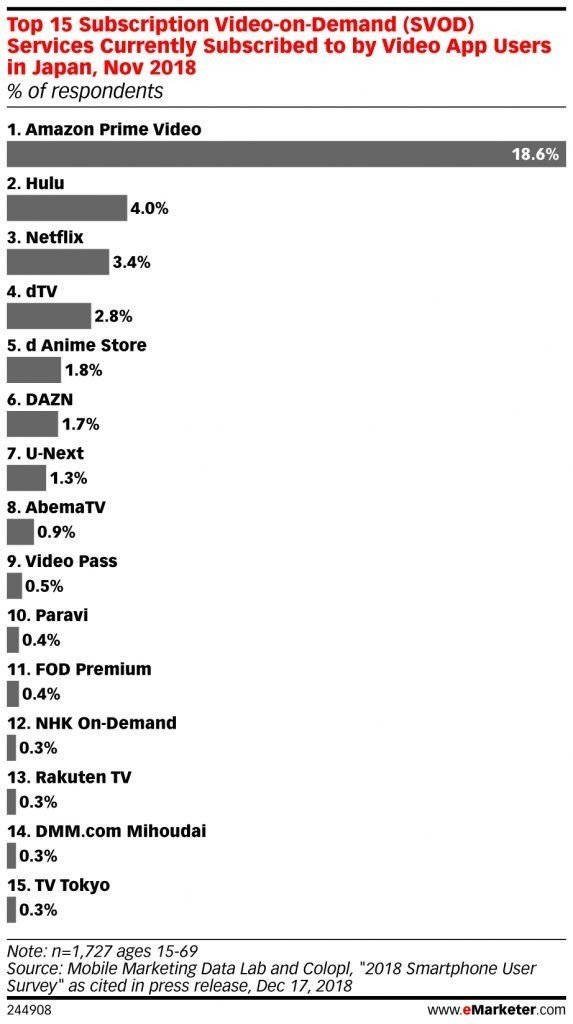
Below are the distribution in the most popular social media used in Japanese population ( 128-129 Million people)
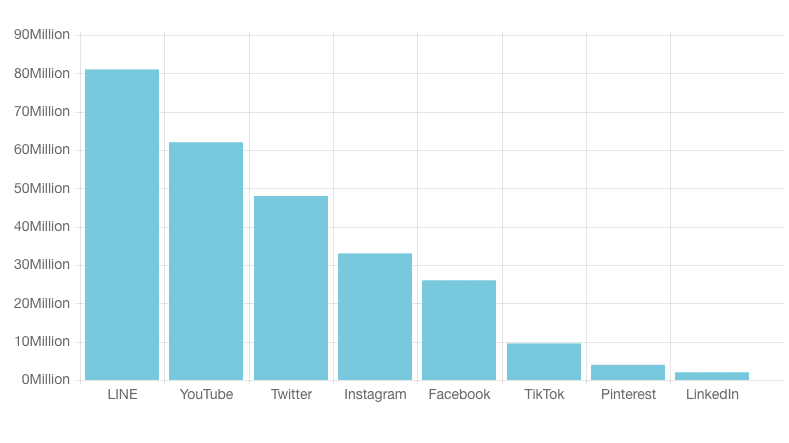
Understanding where the attention is so important. You want to be making noises in the place where there is an attention. Moreover, understanding where the under-priced attention is even more important because then you can reach more people at cheap price. When you know who you are and how you can add value to people, you need to be where the attention is in Japan and start telling your story.
3) Making Brand Kit
Foundation of the brand guidelines
Purpose: Why do you exist?
Vision: What future do you want to help create? What does the future look like?
Mission: What are you here to do? How do you create that future?
Values: What principles guide your behavior?
Message guidelines
This is everything related to how you speak about your company, describe your products, communicate with customers, etc. This includes your:
Brand essence (voice, tone, and personality)
Value prop
Tagline
Messaging pillars
Visual guidelines
Design plays a huge role in your brand’s success. Your guidelines should include a comprehensive visual identity to guide content creation, including:
Colors
Logos
Fonts and typography
Hierarchy
Photography
Illustration
Iconography
Interactive elements
Video and motion
Web design
When you decide what all the above should look like, go ahead and create a brand kit that include all the information above which should be used in the company.
3) Understand the business goals and find out the way to align your branding and marketing to address the goals.
In the end of the day, bad companies will die in long run regardless of how effective strategies are. If your service, product or customer experience is bad, no matter how great your branding is or integrated your branding is with the business goals as such that your branding activity is also an effective business activity, it wouldn't let you succeed. This being said "good company" should have great offering and incredible CX AND, that should be communicated well in a cool way that benefits the business in a long run because branding and sales are two different things and there is a reason for it. Branding should take an account for the company's success in communicating the vision and likability which becomes long term equity of the company whereas sales should focus on closing the sales of today.
4) Cultivate the culture and the "swag" around your brand by incorporating influencers, celebrities, press attentions and things people admire
So with the (3) being said, branding is not about sales. Branding is about creating feelings around your business name. For example,
When we think about Apple vs. Microsoft we come up with different word associated to the each brand.
Apple would associate with feels like: Steve Jobs, Style, Simplicity, Innovative, New, Sophisticated Design, Creative.. etc
MicroSoft would associate with feels like: Bill Gates, Serious, Corporate, Functional, Old fashion, Safe, etc...
You can establish the feels you want to convey by any visual design you associate your brand with or the way you tell your stories, and (influential) people your brand hang out with. You can do this at scale using contents creation, distribution a.k.a social media marketing and influencer marketing. As an example, FashionNove is a new brand who did an incredible job in creating the swag of their own by using social media and influencer marketing.
5) Build brand information center that people can have the access to & keep educating people in the organization who you are, what you believe as a business and identity in any opportunity possible.
Branding is the emotion side of the business and story telling is a powerful tool to create emotion for people to connect with your brand. You can do this by basically talking about who you are and your origin at any opportunity you get. This is why communication in business matters. You need to constantly create opportunities to communicate who you are to your audience whether that is for the market or internal teams.
You can do this by Including who you are page, state your history and educate people why you are who you are today in your corporate home page. You can get involved with volunteering orgnizations that stand for the cause your company mission is trying to solve. You can develop relationships with influential people in your industry and collaborate with them. All this needs to be communicated to tell a story about who you are and ultimately to create your own "swag"and "culture."
All the above being said, the power of creating a media is not ignorable. Just look at all the data pointing where people are spending their time on today and how it is predicting going. By creating a media, each social media post is a new opportunity to reach new audience at no cost and each influencer collaboration is an opportunity to create the culture around your brand which ultimately becomes brand equity in a long run.
How do I know why being a media company works better than being a company that sells product who has a media?
Let's talk about Kylie Jenner from KimKardashian family.
In just four years, Kylie Jenner’s Kylie Cosmetics has hit the $1 billion mark. Kylie Jenne, the 22-year-old beauty influencer and reality TV star leveraged her fame and signature pout to create one of the most lucrative businesses in the beauty industry. 1 billion sale is something that normally takes years of business operation with so many full time employees, Kylie achieved it at 22 years old just by being Kylie Jenner!
As GaryVee says,
Every company needs to be a media company before anything today
🚀 Check Out ForeignConnect Podcast ( Podcast talks about digital transformation, How to start a business abroad & How to Sell abroad) 🖊️ (https://www.foreignconnect.org/podcasts)
🔗 Find out all the resources to start a business abroad 🔗 (https://www.foreignconnect.org/resources)
View The Data Center (https://www.foreignconnect.org/data-center)
Read More Blogs (https://www.foreignconnect.org/blog)
ForeignConnect Services: (https://ja.foreignconnect.org/service)
🚀 E-commerce | 💣 StartUp Incubation
IG | FB | TW | TikTok | Linked In
この記事が気に入ったらサポートをしてみませんか?
